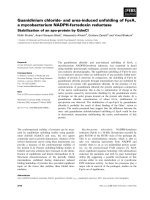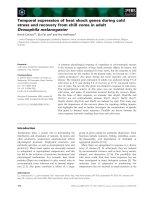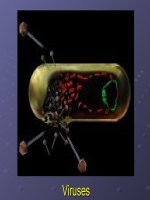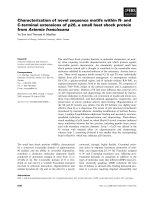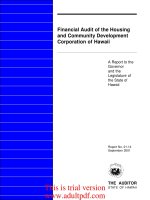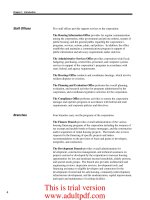STRUCTURE, BEHAVIOR AND MECHANISMS UNDERLYING SENSATION OF CH503, a DROSOPHILA MELANOGASTER PHEROMONE
Bạn đang xem bản rút gọn của tài liệu. Xem và tải ngay bản đầy đủ của tài liệu tại đây (3.69 MB, 158 trang )
DOCTORAL DISSERTATION
STRUCTURE, BEHAVIOR AND MECHANISMS UNDERLYING SENSATION OF
CH503, A DROSOPHILA MELANOGASTER COURTSHIP PHEROMONE
SHRUTI SHANKAR
MSc. Biochemical Technology
A THESIS SUBMITTED
FOR THE DEGREE OF DOCTOR OF PHILOSOPHY
TEMASEK LIFE SCIENCES LABORATORY
DEPARTMENT OF BIOLOGICAL SCIENCES
NATIONAL UNIVERSITY OF SINGAPORE
2015
ii
“DECLARATION
I hereby declare that this thesis is my original work and I have written it in its entirety. I have
duly acknowledged all the sources of information which have been used in this thesis.
This thesis has also not been submitted for any degree to any university previously”.
iii
ACKNOWLEDGEMENT
I would like to thank my ‘guru’, Joanne, for accepting me as one of her first PhD students,
giving me the opportunity to study in Singapore, and above all, for the discovery of CH503
and an enjoyable PhD experience. Joanne has set a wonderful example for me, by being both
a terrific scientific mentor and an extremely compassionate and warm person. I am very
grateful to Joanne, for encouraging me to think independently, giving me a lot of freedom to
design experiments, and motivating me to put in my best effort at work. I will always be
thankful for all the time she has patiently invested in helping me edit numerous presentations,
conference posters and papers. I will never forget our long conversations over email, about
science, my annoyances, good books and how to deal with life. It made me happy to walk into
lab each day, to work with Joanne and my lab mates.
I would like to thank Temasek Life Sciences Laboratory for providing me with excellent
facilities and supporting my PhD studies.
A million thanks to my lab mates Kah Junn and Jia Yi for their valuable contributions-for
generating the Gr68a mutant and other fly strains, meticulously carrying out immunostaining
experiments and helping me with several screens. I would also like to thank Ruifen for her help
in generating the Gr68a mutant. I am extremely grateful to Meredith for her help with
establishing calcium imaging assays, for motivating me to keep trying harder and to think of
alternate methods, during the times I was near to giving up, and helping me develop a keen
interest in microscopy. I would like to thank Wan Chin for her help with gustatory receptor
screen and all my attachment students for their contributions and sharing my enthusiasm about
this project. I am also thankful to my lab mates Jacqueline, Yin Ning, Soon Hwee, and Emilie
for being wonderful people to work with, and for their eternal willingness to help.
I have been extremely lucky to have Prof. Kenji Mori as a collaborator. I would like to thank
Prof.Mori for introducing me to the fascinating concept of pheromone chirality, and giving me
the opportunity to co-author many chemistry papers. I thank my thesis committee members
Dr.Adam-Claridge Chang, Dr.Tong-Wey Koh and Prof. Daiqin, for their invaluable
suggestions on my work.
I am deeply grateful to my parents and brother for supporting my decision to pursue a PhD,
and for visiting me on several occasions to make sure I was doing well and for patiently
listening to me talk about CH503. I am also grateful to have found friends like Ranjit and Ekta,
who have given me great company and support over the years. Lastly, I would like to thank my
art teacher, ‘Lao Shi’, for making my weekends enjoyable.
iv
TABLE OF CONTENTS
TOPIC PAGENUMBER
ACKNOWLEDGEMENT iii
TABLE OF CONTENT iv
LIST OF FIGURES vi
ABBREVIATIONS ix
SUMMARY xvii
CHAPTER 1: INTRODUCTION
1.1 PHEROMONES MEDIATE INNATE BEHAVIORS IN ANIMALS 1
1.2 COURTSHIP BEHAVIOR OF DROSOPHILA MELANOGASTER 2
1.3 PHEROMONES OF DROSOPHILA MELANOGASTER 8
1.4 ORGANIZATION OF THE DROSOPHILA BRAIN 12
1.5 NEUROTRANSMITTERS OF DROSOPHILA MELANOGASTER 14
1.6 THE CHEMOSENSORY ORGANS OF DROSOPHILA MELANOGASTER 16
1.7 NEUROGENETIC CONTROL OF COURTSHIP BEHAVIOR 28
1.8 OLFACTORY PHEROMONE CIRCUIT 41
1.9 THE DISCOVERY OF CH503 AND RESEARCH HYPOTHESES 45
CHAPTER 2: MATERIALS AND METHODS
2.1 FLY STOCKS 49
2.2 COURTSHIP ASSAYS 49
2.3 IMMUNOHISTOCHEMISTRY 51
2.4 SPINNING DISK CONFOCAL MICROSCOPY 52
2.5 PROBOSCIS EXTENSION REFLEX (PER) ASSAY 55
2.6 DETERMINING THE VOLATILITY OF CH503 57
2.7 GENERATION OF TRANSGENIC FLIES 58
2.8 GENERATION OF ΔGr68a AND ΔGr68a-RESCUE (Gr68a
Res
) FLIES 60
2.9 CHEMICAL REAGENTS 60
v
CHAPTER 3: RESULTS
PART 1: STRUCTURAL CHARACTERIZATION OF CH503
3.1 ELUCIDATION OF THE STEREOSTRUCTURE OF CH503 64
3.2 RESULTS AND DISCUSSION 65
3.3 BIOACTIVITY OF THE CH503 STEREOISOMERS 67
3.4 DISCUSSION 71
PART 2: THE CH503 NEURAL CIRCUITRY
3.5.1 MALE COURTSHIP BEHAVIOR IS INHIBITED IN A 74
DOSE DEPENDENT MANNER BY CH503
3.5.2 CH503 IS A LOW VOLATILITY CONTACT CUE AND IS 75
EFFECTIVE ONLY WHEN DETECTED ON FEMALE CUTICLES
3.5.3 CH503 IS DETECTED BY GUSTATION, NOT OLFACTION 77
3.5.4 MEASURING A TASTE RESPONSE TO CH503 USING THE 79
PROBOSCIS EXTENSION REFLEX (PER) ASSAY
3.5.5 Voila
1
/ TM3 GUSTATORY MUTANTS SHOW A REDUCED 82
RESPONSE TO CH503
3.5.6 (R,Z,Z)-CH503 IS DETECTED BY GR68A NEURONS ON THE MALE 85
FORELEG
3.5.7 EXPRESSION PATTERN OF GR68a 90
3.5.8 MEASURING PHYSIOLOGICAL RESPONSES TO CH503 92
FROM Gr68a NEURONS
3.5.9 THE ROLE OF ppk23 NEURONS IN CH503 DETECTION 97
3.5.10 IDENTIFICATION OF HIGHER ORDER NEURONS 103
INVOLVED IN CH503 DETECTION
CHAPTER 4: DISCUSSION 117
CHAPTER 5: FUTURE DIRECTIONS 130
REFERENCES 133
vi
LIST OF FIGURES AND TABLES
CHAPTER 1: INTRODUCTION
Figure 1: Chemical structures of insect pheromones
Figure 2: The hallmark courtship features of male Drosophila
Figure 3: Pheromones of Drosophila
Figure 4: General pathway for pheromone biosynthesis in Drosophila
Figure 5: Structural components of the Drosophila brain.
Figure 6: Mode of action of neurotransmitters
Table 1: Drosophila melanogaster neurotransmitters
Figure 7: Schematic showing the frontal view of the fly head with the antennae and the
maxillary palps
Figure 8: The organization of the olfactory circuit in adult flies
Figure 9: The gustatory organs of the fly
Figure 10: The Drosophila sex-determination pathway
Figure 11: Sex-specific splicing of the Drosophila sex-determination genes
Figure 12: Morphological differences between male and female Drosophila.
Figure 13: The Organization of Dsx neuronal clusters in the CNS
Figure 14: The Drosophila apoptosis pathway.
Figure 15: Sex-specific splicing of the fruitless gene
Figure 16: Neuronal pathways mediating receptivity in female Drosophila
Figure 17: Olfactory pheromone circuits
Figure 18: The anatomical differences in the projection patterns of Or67d PNs in males
and female flies.
Figure 19: The cVA circuit in the male brain comprising of 4 neuronal clusters linked
by 3 synapses
Figure 20: The bidirectional cVA circuit
Figure 21 A]: Schematic of the UV-LDI-o-TOF MS method
B] Picture of the anogenital region of a male fly
Figure 22: The chemical structure of CH503
vii
CHAPTER 2: MATERIALS AND METHODS
Figure 1: Fly mounted on a coverslip for imaging studies.
Figure 2: Calcium imaging
Figure 3: Proboscis Extension Reflex Assay
Figure 4: Experimental setup to determine the volatility of CH503.
Figure 5: The GAL4-UAS system
CHAPTER 3-PART 1: STRUCTURAL CHARACTERIZATION OF CH503
Figure 1: The structural analogs of CH503.
Figure 2: The stereoisomers of CH503
Figure 3: Bioactivity of CH503 stereoisomers
Figure 4: Calculation of effect sizes for courtship data
Figure 5: HPLC separation of CH503 stereoisomers
Table 1: Bioactivity of CH503 analogs
CHAPTER 3- PART 2: THE CH503 NEURAL CIRCUITRY
Figure 1: (R,Z,Z)-CH503 is a courtship inhibitory pheromone.
Figure 2: CH503 has low volatility
Figure 3: Flies can detect CH503 without the major olfactory organs
Figure 4: CH503 inhibits the sucrose induced appetitive Proboscis extension response
Figure 5: Study of Voila
1
/TM3 gustatory mutants
Figure 6: Screen of foreleg specific Gustatory receptor neurons
Figure 7: Knockdown of Gr68a or deletion of Gr68a reduces sensitivity to CH503
Figure 8: Deletion of Gr68a does not induce a suppression of the appetitive PER to
CH503
Figure 9: Artificial activation of Gr68a neurons with TrpA1
Figure 10: Expression pattern of Gr68a GAL4
Figure 11: The response profile of male specifc Gr68a neurons to CH503
Figure 12: Physiological response of Gr68a to (R)-3-acetoxy-11-octacosen-1-ol
Figure 13: Physiological response of Gr68a neurons to (S)-3-acetoxy-11-octacosen-1-ol
Figure 14: Physiological response of Gr68a > Gr68a RNAi flies to (R,Z,Z)-CH503
Figure 15: Physiological response of ΔGr68a flies to (R,Z,Z)-CH503
viii
Figure 16: Response of Gr68a neurons on the female foreleg to (S,Z,Z)-CH503
Figure 17: The response profile of ppk23 neurons to CH503
Figure 18: Color-coded time course images showing responses of Gr68a ans ppk23
neurons to CH503
Figure 19: RNAi mediated knockdown of ppk23 or ppk25 does not alter sensitivity to
CH503
Figure 20: Screen to identify CH503 processing circuits
Figure 21: Screen to identify CH503 processing circuits
Figure 22: Courtship inhibition difference for central brain circuits
Figure 23: Expression patterns of NPF GAL4 and c929 GAL4 neuronal circuits in the
adult male fly brains
Figure 24: Components of the NPF signalling pathway are not involved in CH503
detection
Figure 25: Courtship inhibition difference for NPF signalling pathway
Figure 26: Role of TK circuits in CH503 detection
Figure 27: Co-localization of NPF and TK neuronal circuits
Figure 28: Synaptic connectivity of Gr68a and TK circuits
Figure 29: A model for gustatory pheromone perception
Table 1: Gr68a cell counts in male and female forelegs
Table 2: Sample sizes for calcium imaging experiments
Table 3: Screen of GAL4 lines associated with higher order brain circuits for CH503
detection defects
CHAPTER 4: DISCUSSION
Figure 1: Line graph showing the tonic response pattern of a Gr68a neuron
Figure 2: Line graph showing the phasic response pattern of a ppk23 neuron
ix
LIST OF ABBREVIATIONS
5HT serotonin
7,11-HD 7,11-Heptacosadiene
7,11-ND 7,11-Nonacosadiene
7-T 7-Tricosene
AbdB Abdominal B
AL Antennal Lobe
AMMC Antennal Mechanosensory and Motor Centre
CH503 3-acetoxy-11,19-octacosadien-1-ol
cVA cis-vaccenyl acetate
cVOH cis-vaccenol
CX Central Complex
Cyo curly Oster
DA dopamine
DCO Dorsal Cibarial Sense Organ
DEG/ENaC Degenerin and epithelial Na
+
channel
Desat desaturase
DLP Dorso-Lateral Protocerebrum
dORKΔC Drosophila Open Rectifier Potassium Channel
Dsx Doublesex
Dsx
F
Female specific Doublesex protein
Dsx
M
Male specific Doublesex protein
DTi Diphtheria toxin
EB Ellipsoid body
Elav embryonic lethal abnormal visual system
EPSP Excitatory Post Synaptic Potential
ESI-MS Electrospray ionization- Mass Spectrometry
FB Fan shaped body
x
Fru Fruitless
Fru
M
Male specific Fruitless protein
GABA Gamma-aminobutyric acid
GAL 80 Galactose 80
GAL4 Galactose 4
GCaMP green fluorescent protein (GFP), calmodulin, and M13
GC-MS Gas Chromatography-Mass Spectrometry
GFP Green Fluorescent Protein
GPCR G-Protein Coupled Receptor
GR Gustatory Receptor
GRASP GFP reconstitution across synaptic partners
GRN Gustatory Receptor Neuron
Hid Head involution defective
Hox Homeobox
HPLC High-performance liquid chromatography
HPTLC High-performance thin layer liquid chromatography
IR Ionotropic Receptor
Kr-GFP Kruppel-Green Fluorescent Protein
LH Lateral Horn
LP Lateral Protocerebrum
LSO Labral Sense Organ
m/z mass to charge ratio
MB Mushroom Body
ME Medulla
mRNA messenger Ribo Nucleic Acid
NPF long Neuropeptide F
NPFR1 Neuropeptide F Receptor 1
Oe
-
oenocyteless
Orco Odorant receptor co-receptor
ORN Olfactory Receptor Neuron
xi
OSN Olfactory Sensory Neuron
PCD Programmed Cell Death
PER Proboscis Extension Reflex
PI pars intercerebralis
PN Projection Neuron
Ppk Pickpocket
RNAi RNA interference
Rpr Reaper
SAG Sex peptide Abdominal Ganglion neurons
SEZ Sub-esophageal zone
Shi(ts) Shibire-temperature sensitive
SMP Superior Medial Protocerebrum
sNPF short Neuropeptide F
sNPFR short Neuropeptide F Receptor
SP Sex Peptide
SPR Sex Peptide Receptor
SPSN Sex Peptide Sensory Neuron
Sxl Sex lethal
TA tyramine
TAG Thoracico Abdominal Ganglion
TK Tachykinin
TM3 Third Multiple 3
TM6 Third Multiple 6
TNT Tetanus Toxin
Tra Transformer
TRPA1 Transient receptor potential cation channel, subfamily A, member 1
Tsh tea-shirt
UAS Upstream Activating Sequence
UV-LDI-O-TOF MS ultraviolet laser desorption/ionization orthogonal time-of-flight
mass spectrometry
VLP Ventro Lateral Protocerebrum
xii
VNC Ventral Nerve Cord
VSCO Ventral Cibarial Sense Organ
ΔF/F Relative change in fluorescence
xiii
SUMMARY
The stereotyped courtship behavior of the genetically tractable model Drosophila
melanogaster is orchestrated by neural networks and driven by pheromones and other sensory
signals. While the neural pathways involved in olfactory pheromone detection have been
studied has been well studied, little is known about the neural mechanisms mediating the
sensation of taste pheromones. The overall aim of this project is to characterize the neural
circuitry underlying male courtship behavior in D. melanogaster by examining how the
recently discovered sex pheromone CH503 is perceived and processed into a behavioral
response. This first part of this thesis describes the behavioural characterization of the synthetic
stereoisomers of CH503. The second part of the thesis describes the neural mechanisms
underlying the detection of CH503. CH503 is characterized as a taste pheromone. Using
behavioral analysis, genetic manipulation, and live calcium imaging, Gr68a expressing neurons
on the forelegs of male flies were found to exhibit a sexually-dimorphic physiological response
to the pheromone and relay information to the central brain via peptidergic neurons. The release
of tachykinin from 8-10 cells within the suboesophageal zone is required for the pheromone-
triggered courtship suppression. Taken together, this work describes a neuropeptide modulated
central brain circuit that underlies the programmed behavioral response to a gustatory sex
pheromone. These results will allow further examination of the molecular basis by which innate
behaviors are modulated by gustatory cues and physiological state.
xiv
2
1. INTRODUCTION
Pheromones mediate chemical communication between conspecifics and act on neurons to
trigger innate behaviors. In order to understand how neurons shape behaviors it is important to
know about the organization of the nervous system. In Drosophila melanogaster, courtship
behavior has been used as a paradigm to study how pheromones influence innate behaviors and
to understand the neuronal basis of pheromone perception. The anatomical, cellular and
molecular basis of chemosensory detection has been well studied for olfactory pheromones.
However, less is known about the detection of gustatory pheromones. To study this, we sought
to understand how the gustatory pheromone CH503 influences the courtship behavior of male
Drosophila. This section provides an overview of what is known about the anatomy and
neurochemistry underlying the chemosensory detection in Drosophila melanogaster. This part
culminates with a note on the discovery of CH503 and introduces the reader to the main
research objectives of this thesis work.
3
1.1 PHEROMONES MEDIATE INNATE BEHAVIORS IN ANIMALS
In animals, many innate behaviours and communication between conspecifics (members of the
same species) are triggered by signalling molecules known as pheromones (Karlson and
Luesher, 1959). Pheromone molecules exhibit diverse structural and functional properties and
are known to be detected by the chemical senses of smell and taste. Ever since the first
discovery of the silk moth pheromone bombykol (Figure 1) by Butenandt in 1959, a number
of pheromones have been discovered in invertebrates and vertebrates. In insects alone, there
exist thousands of pheromones. Pheromones trigger a number of innate social behaviours such
as aggregation and aggression, alarm responses, kin recognition and mate choice. For example,
in social insects like the honey bee, individuals known as foragers signal to conspecifics within
the hive about the availability of food resources in the absence of light by executing the well-
characterized waggle dancing behavior. During the course of the waggle dance, a blend of
olfactory pheromones that include Z-tricosene and Z-pentacosene are released to induce food
foraging behavior in other members of the hive (Figure 1) (Thom et al., 2007).
CH
3
CH
3
CH
3 CH
3
CH
3
OH
Figure 1. Chemical structures of a few insect pheromones
In addition, pheromones can also mediate developmental processes. Some well-known
examples are, the mouse urinary protein (MUP) of male mice serves to trigger puberty in
female mice (Mucignat-Caretta et al., 1995). In the nematode worm C.elegans, the dauer
pheromone initiates a developmental program that directs worms into enter an inactive
Z-(9)-tricosene
Z-(9)-pentacosene
Bombykol
4
larvalstage known as the dauer, under conditions of starvation or high population densities
(Butcher et al., 2007)
1.1.1 CHIRALITY OF PHEROMONES
One of the most intriguing themes in pheromone science is the profound influence the chirality
of a pheromone molecule can have on its biological activity. A chiral atom has chemical bonds
with different functional groups. Molecules that differ in the orientation of these functional
groups are classified as chiral, and the different structural forms are known as enantiomers.
Naturally occurring pheromones often occur as a blend of enantiomers or may exist as a single
enantiomer. For example, the pheromone tribolure of the red flour beetle is a blend of four
enantiomers (Suzuki et al., 1980).
Chirality, contributes to the vast diversity observed in pheromone structure and function (Mori,
2007). In this light, let us consider the chiral molecule frontalin, used both as an aggregation
pheromone by scolytid beetles and as an indicator of sexual receptivity by male Asian elephants
(Mori, 1975). How does a single pheromone mediate behaviors across varied phyla? Frontalin
exists in two different enantiomers, non-superimposable mirror images of each other. These
are designated (-)-frontalin and (+)-frontalin. In scolytid beetles (-)-frontalin is bioactive while
in male elephants, an equal ratio of both enantiomers is used. Thus, chirality can provide
functional diversity of a pheromone. This observation has been found recurrently from studies
and synthesis of insect pheromones (Mori, 2007).
A second interesting example is that of the sex specific role of the olive fruit fly pheromone,
Olean. Although in its natural state, Olean is composed of an equal ratio of (R)-Olean and (S)-
Olean, the R enantiomer works as a sex pheromone in males while the S enantiomer is
functional in females (Haniotakis et al., 1986). The moth pheromone disparlure is synthesized
5
by females and exists as ‘+’ and ‘-’ forms. Only the ‘+’ form is effective as a pheromone, while
the ‘-’ form supresses the activity of the ‘+’ form (Mori et al., 1979).
These examples show that not only is the absolute structure of the pheromone important for
chemical communication, but in some cases, the correct combination of enantiomers in a
particular ratio also are essential.
Although a wide variety of animals utilise pheromones for chemical communication, a deeper
understanding of how these molecules trigger behavioral responses, entails the use of a model
with sufficient genetic tools to permit the elucidation of the genetic and neuronal substrates
mediating their perception. Drosophila melanogaster is an ideal model to study, in this light,
as it is genetically amenable and also uses a number of pheromones for conspecific
communication. Courtship behavior of Drosophila melanogaster being heavily modulated by
sex pheromones, is especially suited for such studies and is described in the following section.
6
1.2 COURTSHIP BEHAVIOR OF DROSOPHILA MELANOGASTER
Male courtship behavior of Drosophila melanogaster has been extensively characterized and
comprises of innate and learned aspects. Courtship steps are executed as a fixed action pattern.
At the sight of a female, a male fly will initiate the courtship sequence by orienting towards the
female. Next, the male uses his forelegs to tap and taste the cuticular surface of the female fly,
to specifically detect aphrodisiacs or anti-aphrodisiac pheromones. Male flies will then perform
a species specific courtship song by vibrating a wing (Figure 2). Male flies additionally exhibit
quivering behavior by vibrating their abdomens at a rate of 6 cycles per second (Fabre et al.,
2012).
Figure 2. The hallmark courtship features of male Drosophila: A male Drosophila melanogaster fly
exhibiting courtship steps towards a female courtship target. The courtship features of Drosophila
comprises of 1. Orientation, 2. Tapping, 3. Wing vibration, and 4. Abdomen curling.
Perception of these substrate-borne mechanical cues will cause a receptive female to stop
moving and allow the male fly to copulate. The male fly will then carry out licking behaviours,
mount the female and then attempt to copulate with her. The chances of a successful copulation
1. Orientation
2. Tapping
3. Wing vibration
4. Abdomen
curling
7
attempt depends largely on the receptivity of a female. Male flies avidly attempt to court a
female irrespective of her age, while newly eclosed virgin females take up to two days to
become receptive to courtship attempts (Manning, 1966). Sexually immature females and
mated females are typically unreceptive and will exhibit different types of rejection behaviours
(Connolly and Cook, 1973). These include running away from a male and kicking (exhibited
by sexually immature virgin females) and extrusion of the ovipositor (exhibited by mated
females). Males that have been rejected by a female will usually go through a phase known as
courtship depression that lasts about two hours, during which they will not attempt to court
other females (Siegel and Hall, 1979). A receptive female on the other hand, will slow down
by pausing at regular intervals and open her vaginal plates to allow the male to copulate. In
addition, visual cues guide female mate choice - female flies are attracted to the wing
interference patterns of males and exhibit a preference for more brightly hued wings (Katayama
et al., 2014). The entire courtship ritual starting from orientation to copulation lasts for about
20 minute (Hall, 1994).
8
1.3 PHEROMONES OF DROSOPHILA MELANOGASTER
Pheromones of D.melanogaster influence behaviors like courtship, aggression and
aggregation, hence impacting reproductive success and evolution. A number of sex
pheromones that influence courtship steps, have been isolated from the cuticular surface of D.
melanogaster (Figure 3).
Drosophila pheromones are usually expressed on the cuticular surface of male and female flies.
Drosophila pheromones are synthesized either in cells called oenocytes (like the diene
pheromones) or in the ejaculatory bulb of male flies (cVA and CH503) (Brieger and
Butterworth, 1970), (Yew et al., 2009). Male and female flies express a unique repertoire of
pheromones. Early investigations using gas chromatography mass spectrometry (GC-MS)
showed that female cuticles are likely to express higher levels of 27 carbon atom hydrocarbons
and males express higher levels of 23 carbon atom compounds (Jallon, 1984). The pheromones
of Drosophila are described below:
7-Pentacosene
Cis-vaccenyl acetate
7-Tricosene
7,11-Nonacosadiene
7,11-Heptacosadiene
Figure 3. Pheromones of Drosophila
9
The anti-aphrodisiac pheromones, cVA and CH503, are oxygenated compounds that
are synthesized by males exclusively in the ejaculatory bulb. cVA is a C-20 compound
and is also known to function as a female aphrodisiac (Kurtovic et al., 2007), and is
involved in aggression (Wang and Anderson, 2010) and aggregation (Bartelt et al.,
1985). cVA is converted to cis vaccenol (cVOH), a less volatile compound. cVOH
inhibits courtship longer than cVA and is known to be effective for 92 hours. (Mane et
al., 1983). cVA can be found in the spermathecae (sperm storage organ) of mated
females.
7-Pentacosene is a C-25 compound and its levels increase in females after mating. It is
synthesized by both males and females and functions as an aphrodisiac (Antony et al.,
1985).
9-Pentacosene serves to induce courtship memory associated with mated females
(Siwicki et al., 2005).
7,11-Nonacosadiene (7,11-ND) is a C-29 compound that is produced by females and
functions as an aphrodisiac. 7,11- Heptacosadiene (7,11-HD) another female specific
aphrodisiac and is a C-27 compound.
7-Tricosene (7-T) is a C-23 compound and is transferred from males to females during
mating and functions as an anti-aphrodisiac (Scott, 1986). Females can also synthesize
7-T, but the synthesis is temporarily controlled to take place only after mating. 7,11-
HD and 7-T prevent interspecies courtship (Coyne et al., 1994).
How are these pheromones synthesized? The hydrocarbons produced in the oenocytes are
synthesized from acetyl CoA by the enzymes are fatty acid synthase and elongase (Kent et al.,
2008) (Figure 4). These precursors are channelled into three biosynthetic pathways to result in
the production of n-alkanes, alkenes or the methyl alkanes. Alkanes are synthesized by the
10
enzyme decarboxylase. Alkenes require desaturase and a decarboxylase. There are two types
of desaturases that have been identified - desat1 and desat2. Desat 1 in present in all populations
of D. melanogaster. Desat 2 produces double bonds at C-5 and C-9, and results in the synthesis
of 5, 9- HD, found only in African D. melanogaster populations (Marcillac et al., 2005). The
fatty acid precursors are also methylated and further converted to methyl alkanes by the
enzymes elongase and decarboxylase. Most of the enzymes involved in pheromone
biosynthesis are expressed in the oenocytes or in the reproductive organs of male and female
flies. Interestingly, the enzyme desat1 is also expressed in neuronal tissue, suggesting that it
may also influence the perception of pheromones (Bousquet et al., 2012).
The oenocytes were shown to play an important role in species recognition and mate choice
(Billeter et al., 2009). Ablating the oenocytes of flies completely abolished cuticular
hydrocarbons. Males lacking oenocytes (oe
-
) were less attractive to wild type (WT) females.
They courted other males vigorously and displayed unusual features like attempting to copulate
with another males head. These behaviors could be supressed by the addition of 7-T. On the
other hand, oe
-
female flies were more attractive to WT males, and when perfumed with cVA,
Figure 4. General pathway for pheromone biosynthesis in Drosophila. Adapted
from (Kent et al., 2008).
11
they were more unattractive to males than WT females that had been perfumed with cVA. This
finding suggests that the diene pheromones serve to modulate the effects of antiaphrodisiac
pheromones. Males of D. erecta, D. simulans and D. yakuba were shown to court oe
-
females
(Billeter et al., 2009). Addition of 7,11-HD to oe
-
females inhibited courtship from males of
the above species, suggesting that it prevents inter-species courtship.
To know how pheromones are detected, it is essential to understand the organization of the
nervous system and chemosensory organs of Drosophila. The next section begins with a brief
description of the Drosophila brain and its compartmentalization into different regions that are
specialized to process a wide variety of sensory stimuli (Section 1.4). The action of
neurotransmitters on hardwired neural circuits, provides insight into how behaviors can be
modulated by an animal’s physiological or motivational state (Section 1.5).
Section 1.6-1.7, covers a description of the olfactory and the gustatory organs of the fly, the
molecular basis by which these organs detect a diverse range of chemical compounds and how
neurons from these peripheral organs link to the brain. Having provided the reader with a basic
background of the Drosophila nervous system, literature on the neuronal, genetic and
pheromonal regulation of courtship behavior are reviewed (Section 1.8-1.9). In contrast to
gustatory circuits, olfactory neuronal circuits have been relatively thoroughly studied. The
Or67d circuit, mediating the response to the anti-aphrodisiac pheromone has been described in
this context (Section 2).


